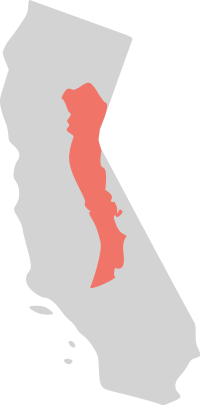Sierra Nevada
| Sierra Nevada | |
|---|---|
 The Sierra'sMills Creekcirque (center) is on the west side of theSierra Crest,south ofMono Lake(top, blue). | |
| Highest point | |
| Peak | Mount Whitney |
| Elevation | 14,505 ft (4,421 m)[1] |
| Coordinates | 36°34′42.9″N118°17′31.2″W/ 36.578583°N 118.292000°W |
| Dimensions | |
| Length | 400 mi (640 km) north-south fromFredonyer PasstoTehachapi Pass[2] |
| Width | 80 mi (130 km)[3] |
| Area | 24,370 sq mi (63,100 km2)[4] |
| Naming | |
| Etymology | 1777:Spanishfor "snowymountain range" |
| Nickname | the Sierra, the High Sierra, Range of Light (1894,John Muir)[5] |
| Geography | |
| Country | United States |
| States | California and Nevada |
| Range coordinates | 38°00′N119°30′W/ 38.000°N 119.500°W |
| Geology | |
| Age of rock | Mesozoic |
| Type of rock | batholith and igneous |
TheSierra Nevada(⫽siˌɛrənɪˈvædə,-ˈvɑːd-⫽see-ERR-ə niv-A(H)D-ə)[6][a]is amountain rangein theWestern United States,between theCentral Valley of Californiaand theGreat Basin.The vast majority of the range lies in the state ofCalifornia,although theCarson Rangespur lies primarily inNevada.The Sierra Nevada is part of theAmerican Cordillera,an almost continuous chain of mountain ranges that forms the western "backbone" of the Americas.
The Sierra runs 400 miles (640 km) north-south and its width ranges from 50 miles (80 km) to 80 miles (130 km) across east–west.[3]Notable features includeGeneral Sherman,the largest tree in the world by volume;Lake Tahoe,the largestalpine lakein North America;Mount Whitneyat 14,505 ft (4,421 m),[1]the highest point in thecontiguous United States;andYosemite Valleysculpted by glaciers from one-hundred-million-year-oldgranite,containinghigh waterfalls.The Sierra is home to threenational parks,twenty-six wilderness areas, ten national forests, and two national monuments. These areas includeYosemite,Sequoia,andKings Canyon National Parks;andDevils Postpile National Monument.
More than one hundred million years ago during theNevadan orogeny,granite formed deep underground. The range started toupliftless than five million years ago,[8]and erosion by glaciers exposed the granite and formed the light-colored mountains and cliffs that make up the range. The uplift caused a wide range of elevations and climates in the Sierra Nevada, which are reflected by the presence of fivelife zones(areas with similar plant and animal communities). Uplift continues due to faulting caused by tectonic forces, creating spectacularfault blockescarpmentsalong the eastern edge of the southern Sierra.
The Sierra Nevada has played an important role in the history of California and the United States. TheCalifornia Gold Rushoccurred in the western foothills from 1848 through 1855. Due to its inaccessibility, the range was not fully explored until 1912.[9]: 81
Name and etymology[edit]

Used in 1542 byJuan Rodríguez Cabrilloto describe aPacific Coast Range(Santa Cruz Mountains), the term "Sierra Nevada" was a general identification of less familiar ranges toward the interior.[11]In 1776,Pedro Font's map applied the name to the range currently known as the Sierra Nevada.[12]
The literal translation is "snowy mountains", fromsierra"a range of mountains", 1610s, from Spanishsierra"jagged mountain range", lit. "saw", from Latinserra"a saw"; and from fem. of Spanishnevado"snowy".[13][14]
While many mountain ranges are unanimously referred to in the plural (Smokies,Rockies,Cascades,etc.), sinceSierrais already pluralized in its native language, some locals who live in "the Sierra" are not hesitant to admonish those who refer to the area as "the Sierras".[15]However, there are historical and literary references that use the plural, such as the 1871 collection ofJoaquin Millerpoems,Songs of the Sierras.[15][16]Ansel Adams,in response to a publication of his photographs under the titleParmelian Prints of the High Sierras,commented, "The nameSierrais already a plural. To add ansis a linguistic, Californian, and mountaineering sin. "[17]
Geography[edit]
The Sierra Nevada lies primarily incentralandeastern California,with theCarson Range,a small but historically important spur, extending into Nevada. West-to-east, the Sierra Nevada's elevation increases gradually from 500 feet (150 m) in theCentral Valley[18]to more than 14,000 feet (4,300 m) atop the highest peaks of its crest 50 to 75 miles (80 to 121 km) to the east. The east slope forms the steep SierraEscarpment.Unlike its surroundings, the range receives a substantial amount of snowfall and precipitation due toorographic lift.
Setting[edit]
The Sierra Nevada's irregular northern boundary stretches from theSusan River[19]andFredonyer Pass[20]to theNorth Fork Feather River.It represents where the granitic bedrock of the Sierra Nevada dives below the southern extent ofCenozoicigneoussurface rock from theCascade Range.[21]It is bounded on the west byCalifornia'sCentral Valley,on the east by theBasin and Range Province,and on the southeast by theMojave Desert.The southern boundary is atTehachapi Pass.[2]
Physiographically, the Sierra is a section of the Cascade–Sierra Mountains province, which in turn is part of the largerPacific Mountain Systemphysiographicdivision. The California Geological Survey states that "the northern Sierra boundary is marked where bedrock disappears under theCenozoicvolcanic cover of the Cascade Range. "[22]
Watersheds[edit]

The range is drained on its western slope by theCentral Valleywatershed, which discharges into thePacific OceanatSan Francisco.The northern third of the western Sierra is part of theSacramento Riverwatershed (including theFeather,Yuba,andAmerican Rivertributaries), and the middle third is drained by theSan Joaquin River(including theMokelumne,Stanislaus,Tuolumne,andMerced Rivertributaries). The southern third of the range is drained by theKings,Kaweah,Tule,andKernrivers, which flow into theendorheic basinofTulare Lake,which rarely overflows into the San Joaquin during wet years.
The eastern slope watershed of the Sierra is much narrower; its rivers flow out into the endorheicGreat Basinof eastern California and westernNevada.From north to south, theSusan Riverflows into intermittentHoney Lake,theTruckee Riverflows fromLake TahoeintoPyramid Lake,theCarson Riverruns intoCarson Sink,theWalker RiverintoWalker Lake;Rush,Lee ViningandMillCreeks flow intoMono Lake;and theOwens Riverinto dryOwens Lake.Although none of the eastern rivers reach the sea, many of the streams from Mono Lake southwards are diverted into theLos Angeles Aqueductwhich provides water toSouthern California.
Elevation[edit]
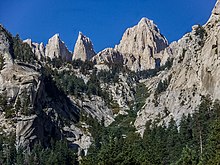
The height of the mountains in the Sierra Nevada increases gradually from north to south. Between Fredonyer Pass and Lake Tahoe, the peaks range from 5,000 feet (1,500 m) to more than 9,000 feet (2,700 m). The crest near Lake Tahoe is roughly 9,000 feet (2,700 m) high, with several peaks approaching the height ofFreel Peak(10,881 ft or 3,317 m). Farther south, the highest peak in Yosemite National Park isMount Lyell(13,120 ft or 3,999 m). The Sierra rises to almost 14,000 feet (4,300 m) withMount HumphreysnearBishop, California.Finally, nearLone Pine,Mount Whitneyis at 14,505 feet (4,421 m), the highest point in thecontiguous United States.
South of Mount Whitney, the elevation of the range quickly dwindles. The crest elevation is almost 10,000 feet (3,000 m) nearLake Isabella,but south of the lake, the peaks reach only a modest 8,000 feet (2,400 m).[23]
Notable features[edit]

There are several notable geographical features in the Sierra Nevada:
- Lake Tahoeis a large, clear freshwater lake in the northern Sierra Nevada, with an elevation of 6,225 ft (1,897 m) and an area of 191 sq mi (490 km2).[24]Lake Tahoe lies between the main Sierra and theCarson Range,a spur of the Sierra.[24]
- Hetch Hetchy Valley,Yosemite Valley,Kings Canyon,andKern Canyonare examples of many glacially-scoured canyons on the west side of the Sierra.
- Yosemite National Parkis filled with notable features such aswaterfalls,granite domes,high mountains, lakes, and meadows.
- Groves ofgiant sequoiasSequoiadendron giganteumoccur along a narrow band of altitude on the western side of the Sierra Nevada. Giant sequoias are the largest trees in the world.[25]
- Two of the largest rivers in California, which form theCentral Valleyand drain intoSan Francisco Bay,derive most of their flow from the western slopes of the Sierra Nevada. The northern of the two is theSacramento River(which also drains the adjacentCascade RangeandKlamath Range); the southern one is theSan Joaquin River.
Communities[edit]
Communities in the Sierra Nevada includeParadise,South Lake Tahoe,Truckee,Grass Valley,Lee Vining,Mammoth Lakes,Sonora,Nevada City,Placerville,Pollock Pines,Portola,Auburn,ColfaxandKennedy Meadows.
Protected areas[edit]

Much of the Sierra Nevada consists offederal landsand is either protected from development or strictly managed. The mountain range is home to threeNational Parks–Yosemite,Kings Canyon,andSequoia– and twonational monuments–Devils PostpileandGiant Sequoia.Ten national forests[26]span much of the mountain range's remaining area. Within these national parks, monuments, and forests lie26 wilderness areas,which together protect 15.4% of the Sierra's 63,118 km2(24,370 sq mi) fromloggingand grazing.[4]
TheUnited States Forest Serviceand theBureau of Land Managementcurrently control 52% of the land in the Sierra Nevada.[4]Logging and grazing are generally allowed on land controlled by these agencies, under federal regulations that balance recreation and development on the land.
The California Bighorn Sheep Zoological Area nearMount Williamsonin the southern Sierra was established to protect the endangeredSierra Nevada bighorn sheep.Starting in 1981, hikers were unable to enter the Area from May 15 through December 15, in order to protect the sheep. As of 2010, the restriction has been lifted and access to the Area is open for the whole year.[27]
Geologic history[edit]


The earliest rocks in the Sierra Nevada aremetamorphicroof pendantsofPaleozoicage, the oldest beingmetasedimentaryrocks from theCambrianin theMount Morrisonregion.[28]These dark-coloredhornfels,slates,marbles,andschistsare found in the western foothills (notably aroundCoarsegold,west of theTehachapi Pass) and east of the Sierra Crest.[29]The earliest granite of the Sierra started to form in theTriassicperiod. This granite is mostly found east of the crest and north of 37.2°N.[30]In the Triassic and into theJurassic,anisland arccollided with the west coast ofNorth Americaand raised a chain of volcanoes, in an event called theNevadan orogeny.[31]Nearly allsubaerialSierran Arc volcanoes have since disappeared; their remains were redeposited during theGreat Valley Sequenceand the subsequentCenozoicfilling of the Great Valley, which is the source of much of the sedimentary rock in California.
In theCretaceous,asubduction zoneformed at the edge of the continent.[32]This means that anoceanic platestarted to dive beneath theNorth American plate.Magma, formed through the subduction of the ancientFarallon Plate,rose in plumes (plutons) deep underground, their combined mass forming what is called theSierra Nevada batholith.These plutons formed at various times, from 115Mato 87 Ma.[33]The earlier plutons formed in the western half of the Sierra, while the later plutons formed in the eastern half of the Sierra.[30]The Sierra Nevada formed the western margin of a high plateau to the east, theNevadaplano.[34]
Twenty million years ago, crustal extension associated with theBasin and Range Provincecaused extensive volcanism in the Sierra.[35]About 10 Ma, the Sierra Nevada started to form when ablock of crustbetween the Coast Range and theBasin and Range Provincestarted to tilt to the west[36]as heat from the Basin and Range extension thinned the eastern part of the block, making it more buoyant than the western portion of the block. Rivers started cutting deep canyons on both sides of the range. Lava filled some of these canyons, which have subsequently eroded leavingtable mountainsthat follow the old river channels.[37]
About 2.5 Ma, the Earth's climate cooled, andice agesstarted.Glacierscarved out characteristic U-shaped canyons throughout the Sierra. The combination of river and glacier erosion exposed the uppermost portions of the plutons emplaced millions of years before, leaving only a remnant ofmetamorphic rockon top of some Sierra peaks.
Uplift of the Sierra Nevada continues today, especially along its eastern side. This uplift causes large earthquakes, such as theLone Pine earthquakeof 1872.[38]
Climate and meteorology[edit]

The climate of the Sierra Nevada is influenced by theMediterranean climateof California. During the fall, winter and spring, precipitation in the Sierra ranges from 20 to 80 in (510 to 2,030 mm) where it occurs mostly as snow above 6,000 ft (1,800 m). Precipitation is highest on the central and northern portions of the western slope between 5,000 and 8,000 feet (1,500 and 2,400 m) elevation, due toorographic lift.[33]: 69 Above 8,000 feet (2,400 m), precipitation diminishes on the western slope up to the crest, since most of the precipitation has been wrung out at lower elevations. Most parts of the range east of the crest are in arain shadow,and receive less than 25 inches of precipitation per year.[39]While most summer days are dry, afternoon thunderstorms are common, particularly during theNorth American Monsoonin mid and late summer. Some of these summer thunderstorms drop over an inch of rain in a short period, and the lightning can start fires. Summer high temperatures average 42–90 °F (6–32 °C). Winters are comparatively mild, and the temperature is usually only just low enough to sustain a heavy snowpack. For example,Tuolumne Meadows,at 8,600 feet (2,600 m) elevation, has winter daily highs about 40 °F (4 °C) with daily lows about 10 °F (−12 °C).[40]The growing season lasts 20 to 230 days, strongly dependent on elevation.[18]The highest elevations of the Sierra have analpine climate.
The Sierra Nevada snowpack is the major source of water and a significant source of electric power generation in California.[41]Many reservoirs were constructed in the canyons of the Sierra throughout the 20th century, Several major aqueducts serving both agriculture and urban areas distribute Sierra water throughout the state. However, the Sierra casts arain shadow,which greatly affects the climate and ecology of the centralGreat Basin.This rain shadow is largely responsible for Nevada being the driest state in the United States.[42]
Precipitation varies substantially from year to year. It is not uncommon for some years to receive precipitation totals far above or below normal.
The height of the range and the steepness of the Sierra Escarpment, particularly at the southern end of the range, produces a wind phenomenon known as the "Sierra Rotor". This is a horizontal rotation of the atmosphere just east of the crest of the Sierra, set in motion as an effect of strong westerly winds.[43]
Because of the large number of airplanes that have crashed in the Sierra Nevada, primarily due to the complex weather and atmospheric conditions such asdowndraftsandmicroburstscaused by geography there, a portion of the area, a triangle whose vertices areReno, Nevada;Fresno, California;andLas Vegas, Nevada,has been dubbed the "Nevada Triangle", in reference to theBermuda Triangle.Some counts put the number of crashes in the triangle at 2,000,[44]including millionaire and record-breaking flyerSteve Fossett.Hypotheses that the crashes are related in some way to theUnited States Air Force'sArea 51,or to the activities ofextra-terrestrial aliens,have no evidence to support them.[45][46]
Ecology[edit]

The Sierra Nevada is divided into a number ofbiotic zones,each of which is defined by its climate and supports a number of interdependent species.[33]Life in the higher elevation zones adapted to colder weather, and to most of the precipitation falling as snow. Therain shadowof the Sierra causes the eastern slope to be warmer and drier: eachlife zoneis higher in the east.[33]A list of biotic zones, and corresponding elevations, is presented below:
- Thewestern foothill zone,1,000–2,500 ft (300–760 m),[33]: 92 with grassland, oak-grass savanna and chaparral-oak woodland.[18]Gray pine(also known as Foothill pine) is intermixed with the oak woodland.[33]: 95
- ThePinyon pine-Juniperwoodland, 5,000–7,000 ft (1,500–2,100 m) east side only.[33]: 92
- TheSierra Nevada lower montane forest(indicator species:Ponderosa pine,Jeffrey pine), 2,500–7,000 ft (760–2,130 m) west side, 7,000–9,000 ft (2,100–2,700 m) east side.[33]: 92 This biotic zone is notable for containinggiant sequoia.
- TheSierra Nevada upper montane forest(indicator species:Lodgepole pine,Red fir) 7,000–9,000 ft (2,100–2,700 m) west side, 9,000–10,500 ft (2,700–3,200 m) east side.[33]: 92
- TheSierra Nevada subalpine zone(indicator species:Whitebark pine)[47]9,000–10,500 ft (2,700–3,200 m) west side, 10,500–11,500 ft (3,200–3,500 m) east side[33]: 92
- Thealpineregion at greater than 10,500 ft (3,200 m), and greater than 11,500 ft (3,500 m) east side.[33]: 92
History[edit]

Native Americans[edit]
Archaeological excavations placedMartis peopleofPaleo-Indiansin northcentral Sierra Nevada during the period of 3,000 BCE to 500 CE. The earliest identified sustainingindigenous peoplein the Sierra Nevada were theNorthern Paiutetribes on the east side, with theMono tribeandSierra Miwoktribe on the western side, and theKawaiisuandTübatulabaltribes in the southern Sierra. Today, some historic intertribal trade route trails over mountain passes are known artifact locations, such as Duck Pass with itsobsidianarrowheads.The California and Sierra Native American tribes were predominantly peaceful, with occasional territorial disputes between the Paiute and Sierra Miwok tribes in the mountains.[48]WashoandMaiduwere also in this area prior to the era of European exploration and displacement.[49][50]
Initial European-American exploration[edit]
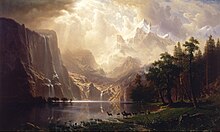
American exploration of the mountain range started in 1827. Although prior to the 1820s there wereSpanish missions,pueblos(towns),presidios(forts), andranchosalong the coast of California, no Spanish explorers visited the Sierra Nevada.[51]The first Americans to visit the mountains were amongst a group led by fur trapperJedediah Smith,crossing north of the Yosemite area in May 1827, atEbbetts Pass.[51]
In 1833, a subgroup of theBonneville Expeditionled byJoseph Reddeford Walkerwas sent westward to find an overland route toCalifornia.Eventually the party discovered a route along theHumboldt Riveracross present-dayNevada,ascending the Sierra Nevada, starting near present-day Bridgeport and descending between the Tuolumne and Merced River drainage. The group may have been the first non-indigenous people to seeYosemite Valley.[52]TheWalker Partyprobably visited either theTuolumneorMerced Grovesofgiant sequoia,becoming the first non-indigenous people to see the giant trees,[51]but journals relating to the Walker party were destroyed in 1839, in a print shop fire in Philadelphia.[53]
Starting in 1841, emigrants from theUnited Statesstarted to move to California viaSonoraandWalker Passes.[54]
In the winter of 1844, Lt.John C. Frémont,accompanied byKit Carson,was the first European American to seeLake Tahoe.The Frémont party camped at 8,050 ft (2,450 m).[55]
Gold rush[edit]

The California Gold Rush began atSutter's Mill,nearColoma,in the western foothills of the Sierra.[56]On January 24, 1848, James W. Marshall, a foreman working forSacramentopioneerJohn Sutter,found shiny metal in thetailraceof a lumber mill Marshall was building for Sutter on theAmerican River.[57]Rumors soon started to spread and were confirmed in March 1848 bySan Francisconewspaper publisher and merchantSamuel Brannan.Brannan strode through the streets of San Francisco, holding aloft a vial of gold, shouting "Gold! Gold! Gold from the American River!"[57]
On August 19, 1848, theNew York Heraldwas the first major newspaper on the East Coast to report the discovery of gold. On December 5, 1848, PresidentJames Polkconfirmed the discovery of gold in an address toCongress.[58]: 80 Soon, waves ofimmigrantsfrom around the world, later called the "forty-niners", invaded theGold Country of Californiaor "Mother Lode". Miners lived in tents, wood shanties, or deck cabins removed from abandoned ships.[59]Wherever gold was discovered, hundreds of miners would collaborate to put up a camp and stake their claims.
Because thegoldin theCaliforniagravel beds was so richly concentrated, the early forty-niners simplypanned for goldin California's rivers and streams.[60]: 198–200 However, panning cannot take place on a large scale, and miners and groups of miners graduated to more complex placer mining. Groups of prospectors would divert the water from an entire river into asluicealongside the river, and then dig for gold in the newly exposed river bottom.[61]: 90
By 1853, most of the easily accessible gold had been collected, and attention turned to extracting gold from more difficult locations.Hydraulic miningwas used on ancient gold-bearing gravel beds on hillsides and bluffs in the gold fields.[58]: 89 In hydraulic mining, a high-pressure hose directed a powerful stream or jet of water at gold-bearing gravel beds. It is estimated that by the mid-1880s, 11 milliontroy ounces(340 metric tons) of gold (worth approximately US$16 billion in 2020 prices) had been recovered by "hydraulicking".[62]A consequence of these extraction methods was that large amounts of gravel,silt,heavy metals,and other pollutants were washed into streams and rivers.[61]: 32–36 As of 1999[update],many areas still bear the scars of hydraulic mining, since the resulting exposed earth and downstream gravel deposits do not support plant life.[61]: 116–121
It is estimated that by 1855, at least 300,000 gold-seekers, merchants, and other immigrants had arrived in California from around the world.[58]: 25 The huge numbers of newcomers brought by the Gold Rush droveNative Americansout of their traditional hunting, fishing and food-gathering areas. To protect their homes and livelihood, some Native Americans responded by attacking the miners, provoking counter-attacks on native villages. The Native Americans, out-gunned, were often slaughtered.[61]
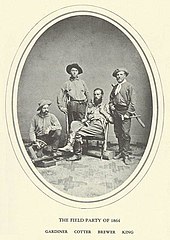
Thorough exploration[edit]
The Gold Rush populated the western foothills of the Sierra Nevada, but even by 1860, most of the Sierra was unexplored.[9][63]The state legislature authorized theCalifornia Geological Surveyto officially explore the Sierra (and survey the rest of the state).Josiah Whitneywas appointed to head the survey. Men of the survey, includingWilliam H. Brewer,Charles F. HoffmannandClarence King,explored the backcountry of what would becomeYosemite National Parkin 1863.[9]In 1864, they explored the area aroundKings Canyon.In 1869,John Muirstarted his wanderings in the Sierra Nevada range,[64]and in 1871, King was the first to climbMount Langley,mistakenly believing he had summitedMount Whitney,the highest peak in the range.[65]In 1873, Mount Whitney was climbed for the first time by 3 men from Lone Pine, California, on a fishing trip.[9]From 1892 to 1897Theodore Solomonsmade the first attempt to map a route along the crest of the Sierra.[9]
Other people finished exploring and mapping the Sierra.Bolton Coit Brownexplored theKings Riverwatershed in 1895–1899.Joseph N. LeContemapped the area aroundYosemite National Parkand what would becomeKings Canyon National Park.James S. Hutchinson,a noted mountaineer, climbed thePalisades(1904) andMount Humphreys(1905). By 1912, theUSGSpublished a set of maps of the Sierra Nevada, and the era of exploration was over.[9]: 81
Logging[edit]
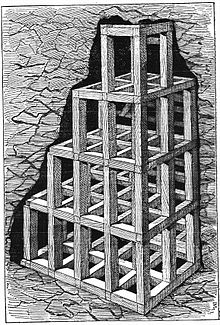
Logging in the Sierra Nevada has significantly impacted the landscape. The logging industry in the Sierra Nevada started in the early 1800s, when settlers relied on hand tools and ox-teams.[66]: 103, 127 Before the California Gold Rush, the industry was relatively small, and most of the lumber used in the state was imported. However, as the demand for lumber to support the mining industry increased, logging became a major industry in the region.
Initially, most of the lumber produced in California was used in mining. TheComstock Lodewas a major center for logging, with operations supplying lumber for the construction of mine structures, such as tunnels, shafts, and buildings, as well as fuel for the mines.Dan DeQuilleobserved in 1876, "the Comstock Lode may truthfully be said to be the tomb of the forests of the Sierra. Millions upon millions of feet of lumber are annually buried in the mines, nevermore to be resurrected.”[67]
In the late 1800s, thelogging industry moved westwarddue to the depletion ofwhite pineforests in the upper Midwest.[68]: 9–14 This shift was encouraged by the positive portrayal of the Sierra Nevada as a promising timber region. In 1859,Horace Greelymarveled, "I never saw anything so much like good timber in the course of any seventy-five miles' travel as I saw in crossing the Sierra Nevada."[69]
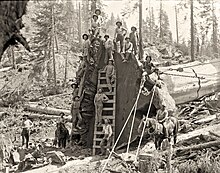
The logging industry experienced significant growth in the late 1800s due to several factors.The Timber and Stone Act of 1878allowed individuals to claim ownership of old-growth timber tracts, which were later consolidated underjoint-stock companies,such as those founded by Midwestern lumber magnates.[71]: 142–144 These companies had the financial resources to transport timber from remote locations and build sawmills near the tracks of theSouthern Pacificrailroad which connected theSan Joaquin Valleyto the rest of the state in the 1870s. This facilitated the nationwide distribution of lumber. In addition, technological advancements, such as theshay locomotiveand thev-shaped log flume,made it easier to transport lumber across mountainous terrain.[66]
Conservation[edit]

The tourism potential of the Sierra Nevada was recognized early in the European history of the range.Yosemite Valleywas first protected by the federal government in 1864. The Valley andMariposa Grovewere ceded toCaliforniain 1866 and turned into a state park.[52]John Muir perceivedovergrazingbysheepand logging ofgiant sequoiato be a problem in the Sierra. Muir successfully lobbied for the protection of the rest of Yosemite National Park: Congress created an Act to protect the park in 1890. The Valley and Mariposa Grove were added to the Park in 1906.[52]In the same year,Sequoia National Parkwas formed to protect the Giant Sequoia: all logging of the Sequoia ceased at that time.
In 1903, the city ofSan Franciscoproposed building ahydroelectric damto floodHetch Hetchy Valley.The city and theSierra Clubargued over the dam for 10 years, until theU.S. Congresspassed theRaker Actin 1913 and allowed dam building to proceed.O'Shaughnessy Damwas completed in 1923.[72][73]
Between 1912 and 1918, Congress debated three times to protect Lake Tahoe in a national park. None of these efforts succeeded, and afterWorld War II,towns such asSouth Lake Tahoegrew around the shores of the lake. By 1980, the permanent population of the Lake Tahoe area grew to 50,000, while the summer population grew to 90,000.[74]The development around Lake Tahoe affected the clarity of the lake water. In order to preserve the lake's clarity, construction in the Tahoe basin is currently regulated by theTahoe Regional Planning Agency.[75]
As the 20th century progressed, more of the Sierra became available for recreation; other forms of economic activity decreased. TheJohn Muir Trail,a trail that followed the Sierra crest from Yosemite Valley toMount Whitney,was funded in 1915 and finished in 1938.[76]Kings Canyon National Parkwas formed in 1940 to protect the deep canyon of theKings River.
In the 1920s, automobile clubs and nearby towns started to lobby for trans-Sierra highways overPiute Pass[77](which would have closed the gap inSR 168) and other locations. However, by end of the 1920s, the Forest Service and the Sierra Club decided that roadless wilderness in the Sierra was valuable, and fought the proposal. The Piute Pass proposal faded out by the early 1930s, with the Forest Service proposing a route overMinaret Summitin 1933.[77]The Minaret Summit route was lobbied against by California's GovernorRonald Reaganin 1972. The expansion of theJohn MuirandAnsel Adams Wildernessesin the 1980s sealed off the Minaret Summit route.[77]
A trans-Sierra route betweenPortervilleandLone Pinewas proposed by local businessmen in 1923.[78]Eventually, a circuitous route across the Sierra was built acrossSherman Passby 1976.[79]
By 1964, theWilderness Actprotected portions of the Sierra as primitive areas where humans are simply temporary visitors. Gradually, 20wilderness areaswere established to protect scenicbackcountryof the Sierra. These wilderness areas include theJohn Muir Wilderness(protecting the eastern slope of the Sierra and the area between Yosemite and Kings Canyon Parks), and wilderness within each of the National Parks.
The Sierra Nevada still faces a number of issues that threaten its conservation. Logging occurs on both private and public lands, including controversial clearcut methods and thinning logging on private and public lands.[80]Grazing occurs on private lands as well as on National Forest lands, which include Wilderness areas. Overgrazing can alter hydrologic processes and vegetation composition, remove vegetation that serves as food and habitat for native species, and contribute to sedimentation and pollution in waterways.[81]A recent increase in large wildfires like the Rim Fire in Yosemite National Park and the Stanislaus National Forest and the King Fire on the Eldorado National Forest, has prompted concerns.[80]A 2015 study indicated that the increase in fire risk in California may be attributable tohuman-induced climate change.[82]A study looking back over 8,000 years found that warmer climate periods experienced severe droughts and more stand-replacing fires and concluded that as climate is such a powerful influence on wildfires, trying to recreate presettlement forest structure may be difficult in a warmer future.[83]
See also[edit]
- Bibliography of the Sierra Nevada
- List of Sierra Nevada road passes
- List of Sierra Nevada topics
- Sierra Nevada (Spain)
Explanatory notes[edit]
- ^Spanish pronunciation:[ˈsjeraneˈβaða];lit. 'snowy range'.[7]
- ^The ship was named afterMount Kearsargein New Hampshire, see"Kearsarge(BB-5) ".Dictionary of American Naval Fighting Ships.Naval History & Heritage Command(NHHC). February 23, 2005.RetrievedDecember 15,2012.
References[edit]
- ^ab"Mount Whitney".NGS Data Sheet.National Geodetic Survey,National Oceanic and Atmospheric Administration,United States Department of Commerce.
- ^ab"Sierra Nevada".Ecological Subregions of California.United States Forest Service. Archived fromthe originalon December 5, 2010.
- ^ab"Sierra Nevada".SummitPost.org.Archivedfrom the original on September 17, 2020.RetrievedMay 29,2010.
- ^abc"The Sierra Nevada Region".USCB Biogeography lab.Archived fromthe originalon July 20, 2011.
- ^Muir, John(1894)."Chapter 1: The Sierra Nevada".The Mountains of California.Archived fromthe originalon April 10, 2014.RetrievedMay 29,2010.
- ^Wells, John C.(2008).Longman Pronunciation Dictionary(3rd ed.). Longman.ISBN978-1-4058-8118-0.
- ^Carlson, Helen S. (1976).Nevada Place Names: A Geographical Dictionary.University of Nevada Press. p. 215.ISBN978-0-87417-094-8.
- ^"Cascade-Sierra Mountains Province (U.S. National Park Service)".nps.gov.Archivedfrom the original on February 12, 2022.RetrievedFebruary 12,2022.
- ^abcdefRoper, Steve (1997).Sierra High Route: Traversing Timberline Country.The Mountaineers Press.ISBN978-0-89886-506-6.
- ^Farquhar, Francis P. (1926)."K".Place Names of the Sierra Nevada.San Francisco: Sierra Club. Archived from the original on March 13, 2006.
{{cite book}}:CS1 maint: bot: original URL status unknown (link) - ^Farquhar, Francis P. (March 1925)."Exploration of the Sierra Nevada".California Historical Society Quarterly.4(1): 3–58.doi:10.2307/25177743.hdl:2027/mdp.39015049981668.JSTOR25177743.Archived fromthe originalon April 30, 2011.
- ^Farquhar, Francis P. (1926)."S".Place Names of the Sierra Nevada.San Francisco: Sierra Club. Archived from the original on May 25, 2024.
{{cite book}}:CS1 maint: bot: original URL status unknown (link) - ^"Sierra".Etymology Online.Archivedfrom the original on August 6, 2011.RetrievedFebruary 27,2011.
- ^"Nevada".Etymology Online.Archivedfrom the original on August 29, 2011.RetrievedFebruary 27,2011.
- ^abMoon, Freda (July 19, 2021)."Is it 'The Sierra' or 'The Sierras'? Californians can't agree".SFGATE.Archivedfrom the original on January 29, 2023.RetrievedJanuary 28,2023.
- ^"POET OF THE SIERRAS, JOAQUIN MILLER, DIES; His Body to be Burned on Pyre at Mountain Home and Ashes Borne by Winds".The New York Times.February 18, 1913.ISSN0362-4331.Archivedfrom the original on July 30, 2021.RetrievedJuly 30,2021.
- ^Adams, Ansel; Mary Street Alinder (1996).Ansel Adams: An Autobiography.NY: Little, Brown & Co. pp. 65–66.ISBN0-8212-2241-4.
- ^abc"Chapter 33-Ecological subregions of the United States, Sierran Steppe - Mixed Forest - Coniferous Forest".United States Forest Service. Archived fromthe originalon January 2, 2014.RetrievedAugust 30,2013.
- ^"Subsection M261Eb: Fredonyer Butte – Grizzly Peak".Archived fromthe originalon December 5, 2010.RetrievedAugust 2,2010.
- ^"Sierra Nevada".Peakbagger.Archivedfrom the original on May 15, 2011.RetrievedAugust 7,2010.
- ^"California Geomorphic Provinces"(PDF).California Geological Survey. 2002. Archived fromthe original(PDF)on July 21, 2004.
- ^"California Geologic Provinces"(PDF).California Geological Survey. p. 2. Note 36. Archived fromthe original(PDF)on December 22, 2016.
- ^"Google terrain map".Archivedfrom the original on September 25, 2023.RetrievedMay 29,2010.
- ^ab"Facts about Lake Tahoe".USGS. Archived fromthe originalon July 21, 2011.RetrievedMay 12,2007.
- ^"The General Sherman Tree".U.S. National Park Service. Archived fromthe originalon March 15, 2010.
- ^Sierra National Forests Indicator Species Amendment Final Environmental Impact Statement(PDF)(Report). p. 5. Archived fromthe original(PDF)on August 16, 2021.RetrievedMay 10,2020.
- ^"Forest Service Proposes to Change Designation of Bighorn Sheep Zoological Areas".United States Forest Service. September 25, 2010.Archivedfrom the original on October 5, 2011.RetrievedJanuary 23,2011.
- ^abStevens, CH; Greene, DC (2000)."Geology of Paleozoic rocks in eastern Sierra Nevada roof pendants, California".Geological Society of America. Field Guide 2.
- ^"Geology and Mineral Deposits of the Mount Morrison Quadrangle, Sierra Nevada, California"(PDF).United States Geological Survey.Archived(PDF)from the original on September 20, 2015.RetrievedDecember 12,2014.
- ^abUnger, Tanya S."Mesozoic Plutonism in the Sierra Nevada Batholith".Archived fromthe originalon September 23, 2015.RetrievedJune 1,2010.
- ^Shaffer, Jeffrey."Evolution of the Yosemite Landscape – The Nevadan Orogeny".One Hundred Hikes in Yosemite.Archived fromthe originalon April 24, 2011.
- ^Blakely, Ron."Geologic History of Western US".Archived fromthe originalon June 22, 2010.RetrievedJune 1,2010.
- ^abcdefghijkSchoenherr, Allan A. (1995).A Natural History of California.UC Press.ISBN978-0-520-06922-0.
- ^Ernst, W. G. (July 1, 2009)."Rise and fall of the Nevadaplano".International Geology Review.51(7–8): 583–588.Bibcode:2009IGRv...51..583E.doi:10.1080/00206810903063315.ISSN0020-6814.S2CID129541879.Archivedfrom the original on September 20, 2021.RetrievedSeptember 20,2021.
- ^Joel Michaelsen."Basin and Range (Transierra) Region Physical Geography".Archived fromthe originalon July 27, 2011.RetrievedMay 7,2010.
- ^Jayko, A.S. (October 18, 2009)."Miocene-Pliocene uplit rates of the Sierra Nevada, California".2009 Portland GSA meeting.Archived fromthe originalon October 23, 2013.RetrievedAugust 25,2012.
- ^Romans, Brian (October 2010)."Inverted Martian Topography".Wired.Archivedfrom the original on December 8, 2013.RetrievedMarch 11,2017.
- ^"1872 Lone Pine Earthquake".Sierra Nevada Virtual Museum.Archived fromthe originalon May 22, 2011.RetrievedMay 31,2010.
Few people ever see a mountain range grow, but on March 26, 1872, the 300 residents of Lone Pine, California, did.
- ^"Average Annual Precipitation".Sierra Nevada Photos. Archived fromthe originalon February 22, 2008.RetrievedJanuary 2,2014.
- ^"Weather".Yosemite.National Park Service.Archivedfrom the original on October 9, 2016.RetrievedOctober 8,2016.
- ^"Water—Most of California's Water Comes from the Sierra Nevada"(PDF).Sierra Nevada Conservancy. Archived fromthe original(PDF)on June 18, 2010.RetrievedJune 9,2010.
- ^"Climatology by state based on climate division data: 1971–2000".NOAA Earth Systems Research Laboratory.Archivedfrom the original on April 21, 2013.RetrievedJuly 11,2010.
- ^Grubišic, Vanda; Billings, Brian J. (2006).Sierra Rotors: A Comparative Study of Three Mountain Wave and Rotor Events(PDF).12th Conference on Mountain Meteorology. American Meteorological Society.Archived(PDF)from the original on July 5, 2011.RetrievedMay 8,2010.
- ^Schoenmann, Joe."The Nevada Triangle: A Graveyard For Planes".knpr.org.Archivedfrom the original on March 2, 2019.RetrievedMarch 18,2019.
- ^Winter, Stuart (January 3, 2010)."Mystery of the Nevada Triangle".Sunday Express.Archivedfrom the original on August 20, 2015.RetrievedSeptember 15,2015.
- ^Pupp, Martin (director) (December 1, 2014).The Missing Evidence: Nevada Triangle(TV series episode).Archivedfrom the original on September 2, 2015.RetrievedSeptember 15,2015.
- ^Fites-Kauffman, J.; P. W. Rundel; N. Stephenson; D. A. Weixelman (2007). "Montane and subalpine vegetation of the Sierra Nevada and Cascade Ranges". In Barbour, M.G.; Keeler-Wolf, T.; Schoenherr, A.A. (eds.).Terrestrial vegetation of California(3rd ed.). Berkeley, CA, USA: University of California Press. pp. 460–501.
- ^Hoffmann, Charles F. (1868)."Notes on Hetch-Hetchy Valley".Proceedings of the California Academy of Sciences.1(3:5): 368–370. Archived fromthe originalon May 9, 2011.RetrievedSeptember 27,2006.
- ^Drake, Bill (2000)."Ancient petroglyph makers of the Northern Sierra".sierrarockart.org. Archived fromthe originalon May 16, 2008.
- ^"Prehistoric Context"(PDF).Idaho-Maryland Mine Project, Master Environmental Assessment.cityofgrassvalley. June 2006. p. 2. Archived fromthe original(PDF)on July 5, 2010.RetrievedAugust 15,2008.
- ^abcWuerthner, George (1994).Yosemite: A Visitors Companion.Stackpole Books. pp.13–14.ISBN978-0-8117-2598-9.
- ^abcSchaffer, Jeffrey P. (1999).Yosemite National Park: A Natural History Guide to Yosemite and Its Trails.Berkeley: Wilderness Press.ISBN978-0-89997-244-2.
- ^Kiver, Eugene P.; Harris, David V. (1999).Geology of U.S. Parklands(5th ed.). New York: John Wiley & Sons.ISBN978-0-471-33218-3.
- ^Farquhar, Francis P. (March 1925)."Exploration of the Sierra Nevada".California Historical Society Quarterly.4(1): 3–58.doi:10.2307/25177743.hdl:2027/mdp.39015049981668.JSTOR25177743.Archivedfrom the original on October 19, 2022.RetrievedDecember 27,2022.
- ^Frémont's "Long Camp".2007 [1999]. Archived fromthe originalon August 19, 2017.RetrievedMay 29,2010.
- ^"California Historic Gold Mines"(PDF).State of California. Archived fromthe original(PDF)on December 14, 2006.
- ^abBancroft, Hubert Howe (1889).History of California, Volume 23: 1843–1850.San Francisco: The History Company. pp. 32–34.
- ^abcStarr, Kevin (2005).California: a history.New York: The Modern Library.
- ^Holliday, J. S. (1999).Rush for riches; gold fever and the making of California.Oakland, California, Berkeley and Los Angeles:Oakland Museum of CaliforniaandUniversity of California Press.p. 60.
- ^Brands, H. W. (2003).The age of gold: the California Gold Rush and the new American dream.New York: Anchor (reprint ed.).
- ^abcdRawls, James J.; Orsi, Richard J., eds. (1999).A golden state: mining and economic development in Gold Rush California (California History Sesquicentennial Series, 2).Berkeley and Los Angeles:University of California Press.
- ^"Mining History and Geology of the Mother Lode".Archived fromthe originalon December 3, 2006.
- ^Moore, James G. (2000).Exploring the Highest Sierra.Stanford University Press.ISBN978-0-8047-3703-6.
- ^Muir, John (1911).My First Summer in the Sierra.Houghton Mifflin.ISBN978-1-883011-24-6.
- ^Leonard, Brendan (n.d.)."Famous U.S. Summits: Mount Whitney, California".REI Co-op Journal.rei /blog: REI Co-op.Archivedfrom the original on July 16, 2018.RetrievedJuly 16,2018.
- ^abJohnston, Hank (1997).The Whistles Blow No More.Stauffer Publishing.ISBN0-87046-067-6.
- ^Straka, Tom; Wynn, Bob (January 17, 2018)."Square-Set Timbering and the V-Flume Kept the Comstock Lode Running Strong".History.net.HistoryNet LLC.Archivedfrom the original on December 27, 2022.RetrievedDecember 27,2022.
The Comstock Lode may truthfully be said to be the tomb of the Sierras. Millions upon millions of feet of lumber are annually buried in the mines, nevermore to be resurrected. When once it is planted in the lower levels, it never again sees the light of day.…For a distance of 50 or 60 miles, all the hills of the eastern slope of the Sierras have been to a great extent denuded of trees of every kind; those suitable only for wood as well those fit for the manufacture of lumber for use in the mines.
- ^Johnston, Hank (2011).Rails to the Minarets: The Story of the Sugar Pine Lumber Company(Fourth Edition (Revised) ed.). Fish Camp, California: Stauffer Publishing.ISBN978-0-9846848-0-9.
- ^Horace, Greely (1859).Overland Journey: New York to San Francisco the Summer of 1859.New York: C.M. Saxton, Barker & Company. p. 280.Archivedfrom the original on March 7, 2023.RetrievedDecember 31,2022.
- ^Zimmerman, Robert (Fall 1998)."Log Flume".American Heritage's Invention and Technology.American Heritage.Archivedfrom the original on November 20, 2022.RetrievedDecember 23,2022.
- ^McDougall Weiner, Jackie (2009).Timely Exposures: The Life and Images of C.C. Curtis, Pioneer California Photographer.Tulare, California: Tulare County Historical Society.
- ^Simpson, John W. (2005).Dam!: Water, Power, Politics, and Preservation in Hetch Hetchy and Yosemite National Park.Pantheon Books.ISBN978-0-375-42231-7.
- ^Righter, Robert W. (2005).The Battle over Hetch Hetchy: America's Most Controversial Dam and the Birth of Modern Environmentalism.Oxford University Press.ISBN978-0-19-531309-3.
- ^"Stream and Ground-Water Monitoring Program, Lake Tahoe Basin, Nevada and California".USGS.Archivedfrom the original on May 30, 2010.RetrievedMay 31,2010.
- ^"Construction Monitoring".Tahoe Regional Planning Agency. Archived fromthe originalon July 16, 2011.
- ^Starr, Walter A. (November 1947). "Trails".Sierra Club Bulletin.32(10).
- ^abcMarsh, Steve (2015)."The High Sierra Piute Highway"(PDF).US Forest Service.Archived(PDF)from the original on August 15, 2021.RetrievedDecember 31,2020.
- ^"Trail Over Mountains Supported".Los Angeles Times.June 15, 1923. p. II10.
- ^"See It All in the Sierra".The Fresno Bee.October 24, 1976.
- ^ab"Forest Issues - CSERC".CSERC.December 16, 2014.Archivedfrom the original on January 21, 2016.RetrievedJanuary 28,2016.
- ^"2014 Grazing Report Released by CSERC - CSERC".CSERC.Archived fromthe originalon February 2, 2016.RetrievedJanuary 28,2016.
- ^Yoon, Jin-Ho; Wang, S.-Y. Simon; Gillies, Robert R.; Hipps, Lawrence; Kravitz, Ben; Rasch, Philip J. (2015)."Extreme Fire Season in California: A Glimpse Into the Future?".Bulletin of the American Meteorological Society.96(11): S5–S9.Bibcode:2015BAMS...96S...5Y.doi:10.1175/BAMS-D-15-00114.1.ISSN1520-0477.OSTI1240234.Archivedfrom the original on February 1, 2016.RetrievedSeptember 26,2016.
- ^Pierce, Jennifer L.; Meyer, Grant A.; Timothy Jull, A. J. (November 4, 2004). "Fire-induced erosion and millennial-scale climate change in northern ponderosa pine forests".Nature.432(7013): 87–90.Bibcode:2004Natur.432...87P.doi:10.1038/nature03058.ISSN0028-0836.PMID15525985.S2CID1452537.

